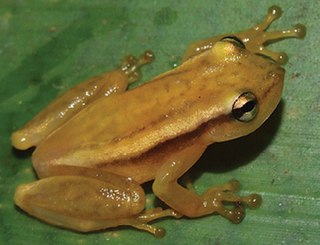The green poison frog is a species of frog in the family Dendrobatidae. They are a small green colored frog, approximately 14-16 millimeters in size. Their color is a uniform green with brighter green back and legs, while the ventral side of the frog is metallic. It is endemic to the western slope of the Cordillera Occidental, Colombia.
The greater bromeliad tree frog is a species of frog in the family Hylidae endemic to the mountains of central Veracruz and northern Oaxaca, Mexico. It has been observed between 450 and 1900 meters above sea level.
The Alagoas heart-tongued frog is a species of frog in the family Hylidae, the tree frogs and allies. It is endemic to Brazil, where it is known from coastal regions in Bahia, Alagoas, and Pernambuco. It has been observed as high as 550 meters above sea level.

Phytotriades is a genus of tree frogs in the family Hylidae. As currently delimited, the genus is monotypic and contains Phytotriades auratus, commonly known as the golden tree frog, bromeliad-dwelling treefrog, El Tucuche golden tree frog, or Trinidad heart-tongued frog.
The Alhandra heart-tongued frog is a species of frog in the family Hylidae endemic to Brazil. It has been observed as high as 100 meters above sea level.

Phyllodytes edelmoi is a species of frog in the family Hylidae endemic to Brazil. It has been observed as high as 650 meters above sea level.
Phyllodytes gyrinaethes is a species of frogs in the family Hylidae endemic to Brazil. Its natural habitat is subtropical or tropical moist lowland forests. It has been observed as high as 710 meters above sea level.

The Brazilian heart-tongued frog is a species of frog in the family Hylidae endemic to Brazil's Atlantic forests. It has been observed as high as 600 meters above sea level.

The Bahia heart-tongued frog is a species of frog in the family Hylidae endemic to Brazil's rainforests. It has been observed as high as 800 meters above sea level.
Phyllodytes punctatus is a species of frogs in the family Hylidae endemic to Brazil. People have seen it as high as 140 meters above sea level.
The Maracas heart-tongued frog is a species of frog in the family Hylidae endemic to Brazil. Its natural habitats are subtropical or tropical dry forests, dry savanna, and moist savanna. People have seen this frog between 900 and 1350 meters above sea level.

Phyllodytes wuchereri is a species of frog in the family Hylidae endemic to Brazil in the Atlantic forest in the state of Bahia. This frog has been observed 400 meters above sea level.
Pristimantis celator is a species of frog in the family Strabomantidae. It is found on the Pacific versant of the western Andes in southern Colombia and northern Ecuador. It is a nocturnal frog that occurs in terrestrial bromeliads found on the sides of roads and in herbaceous vegetation in leafy cloud forests. It tolerates some habitat change as long as bromeliads are present, but is threatened by deforestation.
The half-stripe bromeliad frog or Shreve's robber frog is a species of frog in the family Eleutherodactylidae endemic to Hispaniola and found in both the Dominican Republic and Haiti. Its natural habitats are subtropical or tropical moist lowland forest and subtropical or tropical moist montane forest. It is threatened by habitat loss.

Eleutherodactylus luteolus is a species of frog in the family Eleutherodactylidae endemic to Jamaica. Its natural habitat is subtropical or tropical moist lowland forest. It is threatened by habitat loss.

Phasmahyla spectabilis is a species of frog in the subfamily Phyllomedusinae. It is endemic to Brazil and known from the north-eastern Minas Gerais and adjacent southern Bahia. It occurs in fragments of Atlantic Forest at elevations of about 800 m (2,600 ft) above sea level.People have seen it as high as 850 meters above sea level.

Phyllodytes maculosus is a species of frogs in the family Hylidae endemic to Brazil's rainforests. It has been observed between 77 and 837 meters above sea level.

Andinobates dorisswansonae, the dotted poison frog, is a species of amphibian in the family Dendrobatidae, endemic to Colombia in the outskirts of Falan and north of the department of Tolima. It is toxic to humans.
Phyllodytes megatympanum is a frog in the family Hylidae endemic to Brazil. It has been observed between 90 and 95 meters above sea level.

Phyllodytes praeceptor is a species of frog in the family Hylidae endemic to coastal areas in the state of Bahia in Brazil. It has also been seen in Serra da Jiboia, 694 m above sea level.











